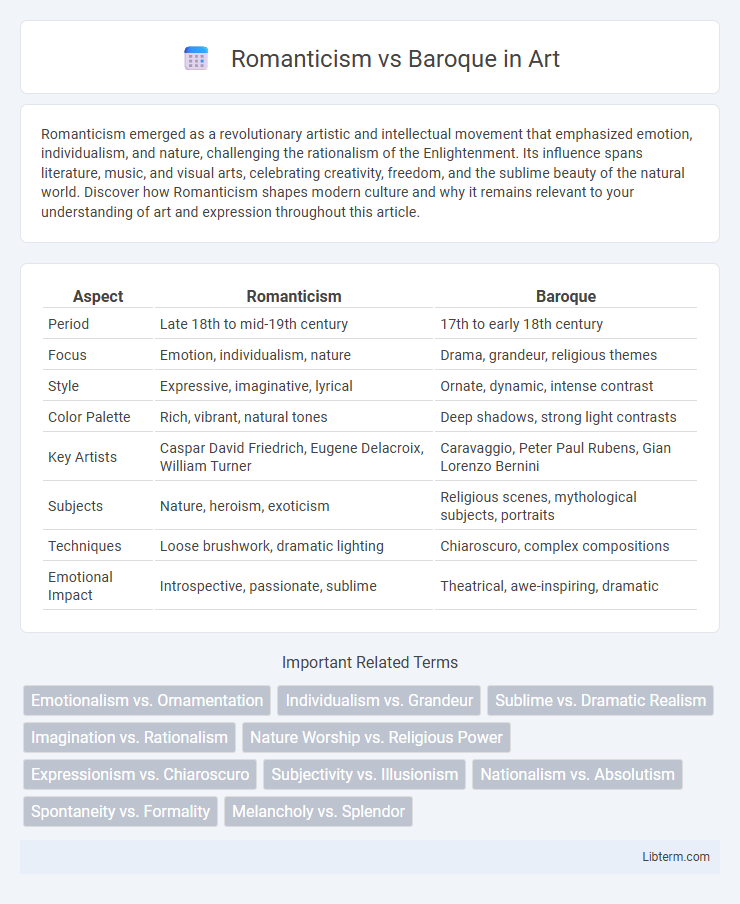Romanticism emerged as a revolutionary artistic and intellectual movement that emphasized emotion, individualism, and nature, challenging the rationalism of the Enlightenment. Its influence spans literature, music, and visual arts, celebrating creativity, freedom, and the sublime beauty of the natural world. Discover how Romanticism shapes modern culture and why it remains relevant to your understanding of art and expression throughout this article.
Table of Comparison
| Aspect | Romanticism | Baroque |
|---|---|---|
| Period | Late 18th to mid-19th century | 17th to early 18th century |
| Focus | Emotion, individualism, nature | Drama, grandeur, religious themes |
| Style | Expressive, imaginative, lyrical | Ornate, dynamic, intense contrast |
| Color Palette | Rich, vibrant, natural tones | Deep shadows, strong light contrasts |
| Key Artists | Caspar David Friedrich, Eugene Delacroix, William Turner | Caravaggio, Peter Paul Rubens, Gian Lorenzo Bernini |
| Subjects | Nature, heroism, exoticism | Religious scenes, mythological subjects, portraits |
| Techniques | Loose brushwork, dramatic lighting | Chiaroscuro, complex compositions |
| Emotional Impact | Introspective, passionate, sublime | Theatrical, awe-inspiring, dramatic |
Understanding Romanticism: Key Features
Romanticism emphasizes intense emotion, individualism, and the sublime in nature, contrasting with the dramatic grandeur and ornate detail of Baroque art. It values spontaneity, imagination, and a deep connection to the natural world, often portraying heroic struggles and exotic themes. The movement embraces personal expression and the exploration of the human spirit beyond the rigid structures characteristic of Baroque aesthetics.
Exploring the Essence of Baroque Art
Baroque art emphasizes dramatic intensity, intricate details, and dynamic movement, captured through its bold contrasts of light and shadow to evoke emotional depth. It embodies grandeur and theatricality, using elaborate ornamentation and vivid realism to engage the viewer intimately. Romanticism, in contrast, prioritizes individual emotion and sublime nature, focusing on personal expression rather than Baroque's structured opulence.
Historical Context: Baroque and Romanticism Timeline
Baroque art and architecture flourished from the early 17th century to the mid-18th century, characterized by ornate details, dramatic expressions, and grandeur linked to the Counter-Reformation and absolute monarchies. Romanticism emerged in the late 18th century and peaked during the early to mid-19th century, as a reaction against Enlightenment rationalism and industrialization, emphasizing emotion, nature, and individualism. The transition between these movements reflects a shift from the structured complexity of Baroque to the expressive freedom and emotional intensity of Romanticism amid changing social and political landscapes.
Major Themes: Emotion vs. Order
Romanticism emphasizes intense emotion, individualism, and the sublime power of nature, celebrating passion and imagination as reactions against the rational order of the Baroque period. Baroque art and music prioritize structured form, harmony, and dramatic tension, reflecting control, grandeur, and the divine hierarchy through ornate detail and balanced composition. The contrasting themes highlight Romanticism's focus on emotional depth and freedom versus Baroque's dedication to order and disciplined expression.
Artistic Styles Compared: Baroque Ornateness and Romantic Passion
Baroque art is characterized by its intricate ornateness, dramatic contrasts of light and shadow, and detailed embellishments that create a sense of grandeur and movement. Romanticism emphasizes emotional intensity and individual expression, with passionate brushstrokes and vivid color palettes that evoke deep feelings and emphasize nature's sublime beauty. While Baroque art focuses on elaborate decoration and theatricality, Romantic art prioritizes personal emotion and imaginative freedom.
Influential Artists in Romanticism and Baroque
Romanticism featured influential artists such as Caspar David Friedrich, whose evocative landscapes emphasized emotional depth, and Eugene Delacroix, renowned for dramatic compositions and vibrant color use. Baroque art was defined by masters like Caravaggio, whose chiaroscuro technique enhanced realism, and Peter Paul Rubens, celebrated for dynamic movement and rich textures. The contrasting styles highlight Romanticism's focus on individual emotion and nature versus Baroque's theatricality and grandeur.
Music and Literature: Expressive Contrasts
Romanticism emphasizes intense emotion, individualism, and nature, reflected in expansive, lyrical music by composers like Chopin and literary works from poets such as Wordsworth that explore deep personal and emotional experiences. Baroque music, characterized by structured forms, ornate complexity, and dramatic contrasts, is exemplified in compositions by Bach and Handel, while Baroque literature features elaborate metaphors and grand themes written by authors like John Milton. The expressive contrast lies in Romanticism's pursuit of spontaneous, emotive expression versus Baroque's disciplined, intricate style that highlights formal balance and grandeur.
Influence on Architecture: Grandeur vs. Imagination
Romanticism influenced architecture with imaginative and expressive designs emphasizing emotion, nature, and individualism, often featuring asymmetrical shapes and intricate details symbolizing freedom and creativity. In contrast, Baroque architecture is characterized by grandeur, dramatic use of light and shadow, bold ornamentation, and symmetrical layouts, aiming to evoke awe and demonstrate power and control. These differing approaches reflect Romanticism's focus on personal expression versus Baroque's emphasis on opulence and structured magnificence.
Legacy and Cultural Impact of Both Movements
Romanticism revolutionized cultural expression by emphasizing individual emotion, nature, and imagination, deeply influencing literature, music, and visual arts with figures like Goethe and Turner shaping modern creative freedom. Baroque's legacy lies in its dramatic intensity and grandeur, seen in monumental architecture such as St. Peter's Basilica and the works of composers like Bach, which continue to inspire classical art and religious aesthetics. Both movements profoundly impacted Western art history, with Romanticism championing personal insight and Baroque epitomizing opulence and dynamic movement.
Romanticism vs. Baroque: Which Resonates Today?
Romanticism emphasizes intense emotion, individualism, and nature's sublime power, contrasting with Baroque's grandeur, ornamentation, and dramatic tension. Contemporary culture resonates more with Romanticism's focus on personal expression and emotional depth, reflecting modern values of authenticity and introspection. However, Baroque's intricate detail and dynamic movement continue to influence architecture and visual arts, maintaining relevance in trends that favor ornate aesthetics.
Romanticism Infographic

 libterm.com
libterm.com